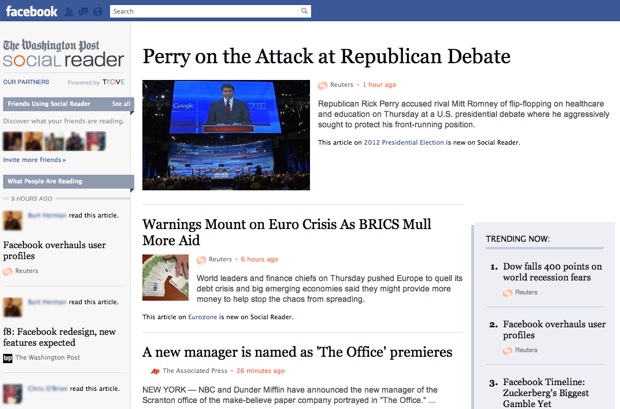 For an industry that is based on diving into the unknown, the news business has been notoriously adverse to exploring real innovation in its own industry--despite the fact that it has been floating in a sea of disruption for at least a decade.
For an industry that is based on diving into the unknown, the news business has been notoriously adverse to exploring real innovation in its own industry--despite the fact that it has been floating in a sea of disruption for at least a decade.
That’s why the work of The Washington Post Company and its two-year-old WaPo Labs is notable. The principles under which the Labs were founded serve as a roadmap for reinvention--not just for the news business but for any company whose once-firmly entrenched industry is now being shaken up.
Founded in 2009, the Labs experiment with new possible news products. They do everything from exploring new infrastructure, to developing new products (like Trove), and experimenting with widgets that can be deployed within the company’s existing publications, like the Washington Post and Slate.
The Labs’ latest effort, the Washington Post Social Reader, was unveiled Thursday at f8, Facebook’s annual developer conference. The new Reader is an app that lives within the social network and, on the surface, looks like a typical news site.
But there are two major differences. First, the stories you see in the Reader are not chosen by editors. Instead, they’re chosen by social signals, including which articles you and your friends read as well as information from your Facebook profile and the things you’ve Liked.
Second, the bucket of stories from which the Reader pulls isn’t limited to material produced by The Washington Post Company itself. It also includes content from outside organizations, like Mashable, SB Nation, and the Sugar network.
Those differences reflect two major shifts away from conventional news industry thinking, Washington Post Company Chief Digital Officer Vijay Ravindran tells Fast Company. While the industry has long prided itself on the acumen of its editors, the Post Company now believes that social will play an increasingly large role in how readers find news they might be interested in.
And while competition between journalistic fiefdoms has long been legendary, the Post Company now believes that aggregation of some kind will be necessary in the future. “No single publisher has enough content to satisfy a reader today,” Ravindran says. The Reader reflected another more fundamental mindset shift: The willingness to try significant experiments with no immediate expectation of financial return.
When asked about the revenue model for the Social Reader, Washington Post Company chairman and CEO Donald Graham tells Fast Company that the primary goal of pursuing the project wasn’t to earn money but to learn about how social elements can improve the news experience for readers.
“I know what readers my age want,” says the 66-year-old Graham. “But the great mystery is what younger readers want.”
After two months of testing the Reader, Graham says, “it’s clear social is going to be a part of it, so we have to learn how to do it.”
While commendable, that type of mindset has typically been lacking in the news world, where efforts at reinventing the business have tended to focus more on business models--like paywalls--rather than on the product itself.
According to Ravindran, an Amazon veteran, much of the credit for that mindset goes to the top brass: Graham, Washington Post publisher Katharine Weymouth, and Post executive editor Marcus Brauchli.
Part of it probably also rests on Ravindran’s shoulders. When asked why a tech veteran who had pioneered technologies and products at a place like Amazon would want to step into an industry that has historically been hostile to technology’s bleeding edge, Ravindran said he had three requirements for accepting the job.
First, he had to be able to put together his own team of technologists--and that, he says, was simply to ensure that he would have the necessary capabilities in-house to prototype any ideas.
“You can’t PowerPoint your way through what the future should be like,” Ravindran says. “You have to be able to show how it’s going to work.”
Second was the requirement that his unit report directly to the chairman of the Post Company. “The ‘innovator’s dilemma’ is ripe at media companies,” Ravindran says, referring to the business classic by Harvard Business School professor Clayton Christensen about why successful organizations have a hard time responding to disruptions within their own industries.
Ravindran says he needed the ability to try experiments without worrying about the impact on--and fighting with the leaders of--different parts of the organization, like advertising and circulation. That would only be possible if the Labs were organizationally separate, and funded separately, from the core publications.
Lastly, Ravindran says, “You need to feel like the patient actually wants to accept what you’re trying to do.” Graham, Weymouth, and Brauchli are people who “get that we need to move fast and we need to take chances,” he says.
“We need to move from being a product for print consumption to being a digital national publication,” albeit one that “obsessively covers Washington,” Ravindran says. And indeed, it’s a vision that Graham seems to embrace.
Going forward, “the mission of a great reporter doesn’t change,” Graham says. “But the way [their work] gets presented to the public is going to change a lot.”
E.B. Boyd is FastCompany.com's Silicon Valley reporter. Twitter | Google+ | Email